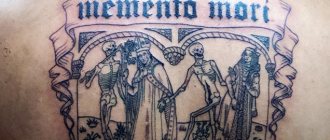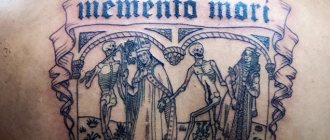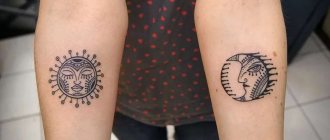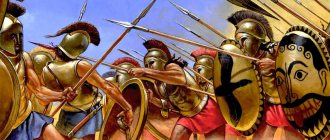There was a tradition in ancient Rome to celebrate the return of a victorious military general with a drawn out spectacle to sanctify the triumphant leader. On the day of his parade, the victor wore a crown and a purple, gold-adorned toga, otherwise reserved for kings. His four-horse chariot parted the streets lined with thanks-givers chanting "io Triumphe!
" The roars of "
Hurray, O Triumph
" was muffled by the whisper of slave, positioned deliberately in the chariot behind his master's throne, "
"Memento Mori, Memento Mori, Memento Mori
," the slave echoed. "
Remember thou art mortal
.” “
Remember, you too must die
.” The perfect reminder during a man’s momentary immortalization.
Modern society regards death as an unpleasant reality best kept far from mind else awakening agonizing terror. But reflecting on and accepting the transient ephemeralness of our existence is the key unlocking lives of meaning and fulfillment. From the slave’s humbling whisper, Memento Mori evolved aesthetically and tangibly. Hamlet held Yorick’s skull, Thomas Jefferson carried a Memento Mori watch key , Mozart wrote his most famous composition Requiem
, and Picasso kept a skull in his studio for purposes synonymous with the slave reminding the Roman general, “
Remember, you too must die.
”
Colby Jimcosky
“To make a long story short, I came to the realization one day that while I’m still young, I’m not getting any younger. My days are numbered and if I wanted to be successful and achieve what I wanted to achieve in life, I needed to constantly keep moving toward those goals. Now whenever I feel like I’m too tired to get out of bed or if I’m too sick to go to work, I can look down at my arm and see a constant reminder that I’m not immortal, I’m going to die one day, and I have to keep moving forward with my life.”
Paul Jun
“When I was failing college and lost in life, I stumbled on the path of becoming a writer. My second year into the craft, I had great momentum-self-published my first book and finished attending Seth Godin’s three-day seminar that fundamentally changed my life.
Toward the end of the year, my psoriasis (didn’t knew I had it) flared up, blanketing my entire body. I fell into a deep depression. I was recommended the book, Meditations
by Marcus Aurelius, and it gave me the framework and energy to flip this experience on its head. That year, I barely left my room, read a book a week, and devoted my time to writing and meditating. My dermatologist, after all, said there was no cure, only lowering my stress.
I remember being at my best friend’s house, watching Ink Masters
, and he asked if I would ever get a tattoo. And I explained to him exactly what you see on my arm today. Jun Cha is my artist, and at the time he had a three year wait-it was also application only.
I got this tattoo of Marcus Aurelius, Nero, and Seneca because it’s a reminder that no matter how smart you may be, no matter how good of a support system you may have, ego can always win. Marcus sits at the top because he’s the North Star, the reminder of how to behave and what to return to when things go awry. Nero had potential to be a great emperor-his first five years were fruitful-but ego won. Seneca is one of those people I deeply admire for his thought but also his story.
Stoicism saved my life. It gave me a new operating system to think about failure, adversity, pain, and uncertainty. It replaced my Windows 98-style thinking and revamped it. It has helped me creatively, professionally, and spiritually. As Montaigne said, ‘For I must use these great men’s virtues as a cloak for my weakness.’ Meditations
and
Letter from a Stoic
are my bible, and it’s the two books I always give to people who are lost in life, in pain, or need new perspective.”
Instagram: @Pauljunbear Tattoo artist: @Juncha Paul Jun’s website: https://pauljun.me
Chris Nordyke
“Here’s my story behind the tattoo – it’s part of a broader sleeve of personal ‘glyphs’- images that tell the story of my 30s. Every picture represents an idea, experience or lesson learned. I intentionally refrained from tattooing any actual words, as I wanted the meaning behind each tattoo to be able to evolve over time.
Stoic philosophy really grabbed hold of me a few years ago as I was wrestling with my own religious and spiritual background. Trying to reconcile the way I experience the real world around me, and the narrative I was taught all through my childhood and young adulthood.
Rob King
"I got mine a few years ago at the Hard Rock in Las Vegas. You can read why this matters so much to me
Surprisingly, but nowadays the death tattoo is in the list of the most popular subjects ordered in tattoo salons around the world. In this case, the image itself is not always perceived negatively, or causes fear.
There are male and female tattoos, subcultural and religious. Some have an implicit meaning, while others are just for beauty, and do not have any particular message or special energy.
In certain circles enjoy success with the angel of death tattoo. They represent Azrael (Malyaku l-mauth in the Arabs). In the classical tradition of the Abrahamic religions, there is no such separate character with a scythe. Therefore, the guide to the afterlife is an angel. Some currents are of the opinion that he is a messenger of God, others identify him with the dark forces.
Tattoo angel of death, with a cross and skull in a black cape
For each branch of religion, nation, culture, the meaning of the angel of death tattoo can be separate. Modern traditions often depict him in the form of an old man, also often tattoo death with a scythe identified with him. Interestingly, the angel responsible for the "affairs of the afterlife" is even in the traditional beliefs of the Chuvash people. There he is called Esrel. References to Judaism are obvious, and do not let them surprise you. The ancestors of the modern Chuvash lived next to the Khazars, who converted to Judaism.
Tattoo of death with a scythe
In Christian countries people often get a tattoo of the seven deadly sins. All vices may be portrayed, or one particular one that a person identifies with himself. Usually it is a person whose image demonstrates some quality recognized as sin in Christianity:
- pride;
- greed;
- envy;
- anger;
- lust;
- gluttony;
- laziness or dejection.
Also very popular are the tattoos "remember death" in Latin. The inscription Memento mori has a long history. It was first mentioned in ancient Rome. When a warlord was returning to his homeland with victory, a slave walked behind him, periodically reminding him that he, despite his successes, was only a mere mortal. In the seventeenth century, this winged expression became a greeting of the monks of the Order of St. Paul. They were called the Brothers of Death.
The inscription tattoo memento mori, translates as - remember death
Gradually, the original meaning of the phrase was forgotten, and in the form of a tattoo, it meant that our existence on earth - a temporary phenomenon. One should remember this in all circumstances.
Tattoos of the Gods of Death
If you're a fan of ancient Egyptian mysticism and admire their pantheon, you'll definitely like the Anubis tattoo of the god of death. A deity depicted with the head of a jackal/dog and a human body. He holds an ankh in one hand and a staff in the other. He is both a guide to the afterlife and one of the judges for human souls.
The tattoo of Anubis, the god of death.
Greek mythology gave us the god Thanatos. He is the patron of all things related to the "other world" and is the sibling of Hypnos, the god of sleep. Some people get a tattoo with both brothers to show how thin the line is between sleep and the process of dying of the physical body.
Also associated with the world of the dead is the name Hades (Hades). He is the brother of Zeus and Poseidon. Although this god does not kill anyone, he guards the realm of the dead, named after him. His image is also popular in the art of tattooing, although inferior to his Egyptian and Greek "counterparts."
The Japanese in modern culture have a separate concept of Shinigami deities. Some authors say there is one god of death, others write that there are many. With the popularization of Japanese culture, similar tattoos began to be done far beyond this country and Asia in general. The most popular shinigami, is Ryuuk, a character from the manga, anime and Death Note movies.
Interesting are the tattoos chosen by fans of Nordic culture. Here the name of the goddess Hel is associated with the world of souls. Her parents are the cunning god Loki and a certain giantess Angrboda. It is believed that when Ragnarok comes, Hel will oppose the Aesir by leading hordes of the dead. This plot is often used in the plots of not only books, but also sketches of tattoos with death.
There are quite a few goddesses in charge of the dead, or commanding the afterlife. One of the key ones is Mara - Morana, aka the Celtic Morrigan. In Ireland to this day, old beliefs are strong, and people often get tattoos depicting this goddess.
Remember deathBooks in still life vanitas
Mystery writing for the initiated
In modern definition, vanitas is a special genre of still life from the Baroque era. Visualization of the artist's thoughts about the frailty of existence, the transience of life, the insignificance of earthly goods and achievements. The Latin name vānĭtās means vanity, ephemerality, uselessness, as well as vanity and vanity. The source is a moralistic maxim from the biblical book of Ecclesiastes: Vanitas vanitatum et omnia vanitas ("vanity vanity, all vanity").
The birthplace of this genre is considered to be the Dutch city of Leiden, one of the largest centers of Calvinism with its pronounced didacticism and the notion of art as a moral lesson. Here, in the 1620s, the aesthetic representation of the material world turns into a painting of the "world of ideas", a conceptual artistic statement. Vanitas calls for more reflection than staring. The objects depicted are the visual elements of a code of meaning. In Yuri Lo's apt observation.
In a strict sense vanitas is the prototype of still life as a later genre. Its iconography originally included the image of the Book and was preceded by pictorial representations of St. Jerome. Particularly expressive are the variations on this subject by Marinus van Reimerswale, notable for its large-scale depiction of the Holy Scriptures surrounded by many other books.
The early vanitas are symbolically overloaded, layered allegorical, and poorly understood by the modern viewer. The later ones are simpler in detail and more transparent in meaning. The simplification is connected with the weakening of the role of the Church and the secularization of society. Earthly passions prevailed over the fear of the afterlife torment for sins. The gloomy symbolism of death gradually gave way to elegiac motifs of the natural fading of life. The concentration of philosophical reflections was diluted with elegiac contemplation of the material world. New vanitas came to be seen as visualized exhortations reminiscent of modern demotivators.
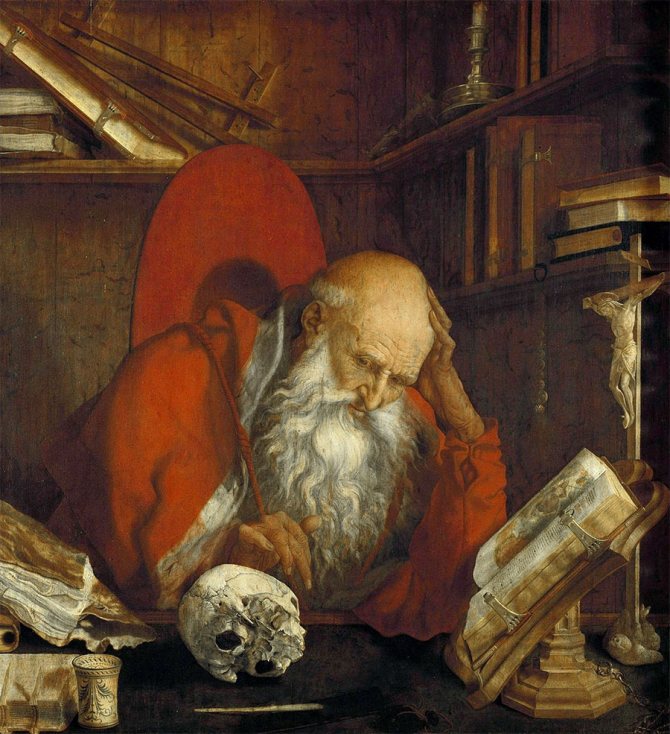
Marinus van Reimerswale "St. Jerome in his cell," c. 1545. 1545 Photo: gallerix.ru
The eternal(ich) world.
Classical vanitas consists of pictorial images of the fragility and transience of life, the ephemerality of successes and pleasures. The compositional center was traditionally the human skull - a symbol of death and spiritual rebirth (Adam's skull at the foot of Calvary). Among other items were wilted flowers, smoldering candles, clocks (the fragility of things, the inexorability of time); jewelry, coins (wealth); mirrors, weapons, laurel wreaths, attributes of power (vanity).
But books are important to us, and they occupy a special place: together with maps and pens, books symbolize the futility of secular science and worldly knowledge, as well as the limits of human reason in comparison to divine providence. This is why books are often depicted as dilapidated or shabby - showing signs of deterioration, destruction, or careless use. Similarly, in Paulo Giovio's 1556 Italian collection of emblems, the image of the book under the crown is complemented by the Latin dictum: Recedant vetera ("Let old things pass away").
In later vanitas, the book is interpreted in many ways: as a learning tool, a way of recording knowledge, a sign of erudition - but also the arrogance inherent in scholars, the perilous audacity of thought, the claim to understand everything and everything. According to the famous classification of the Swedish scholar Ingvar Bergström (1956), books in vanitas belong to the group of things of transient significance, of fleeting value, and to objects describing an intellectually contemplative life (lat. vita contemplativa). Finally, every book depicted in vanitas is an emblematic reminder of the Book of Ecclesiastes, the original source of the quote about "vanity of vanities.
On many canvases the book is depicted not as a specific edition or manuscript, but as a hollow, sham object, a conventional element of the iconography of memento mori (Latin for "remember death"). Its very presence in a painting has a generalized emblematic meaning of an objectified rhetorical figure, a sign of past events, eternally frozen in words. Such depictions are found, for example, in the works of Pieter Claes (1597-1661) and Harmen van Steenwijk (1612-1659).
Painted texts
Much more curious is vanitas with the book as a carrier of a specific text and independent meaning. In Still Life with Books and Violin by Jan David de Haem (1606-1683/1684), for example, the theme of the frailty of existence is understood in the artist's contemporary cultural realities. The seeming piling up of objects is deceptive - the composition follows a strict emblematic logic. In the absence of the skull, the book - a play by the Dutch playwright Gerbrand Adriaens Bredero, Rodderick and Alphonse (1611), extremely popular among his contemporaries and full of imagery of "vanity of vanities" - becomes the center of attraction. Next to it is an open-ended collection by Jacob Westerbaen, whose famous poem "Praise of the Herring" is glorified on a canvas by Joseph de Bray (1632-1664).
The foreground vanitas by Pieter van Steenwijk (1615-1654), Ars long, vita brevis, depicts another play, Aron and Titus (1641) by Jan Vos. The protagonist is a fictional ancient Roman warlord, filled with a thirst for revenge on the queen, who in turn also takes revenge on him. This painting has a substantial resonance with Jurian van Streck's Vanitas vanitatum (1632-1687), in which we see Sophocles' tragedy Elektra in the Dutch translation on the title page. The external meaning of both portrayals of the books is the inevitability of retribution for crimes, the inevitability of the highest judgment on man. This is essentially what all the tragedies tell us about.
The subtext of these two still lifes associated with the images of books encapsulates the idea of creative continuity and inheritance of traditions in art. The play Aron and Tatus is inspired by Vos's early Shakespearean tragedy Titus Andronicus. And the title of Elektra bears the name of the translator Joost van den Vondel, the famous Dutch poet. This interpretation is reinforced by the Latin maxim that gave its title to Stenwijk's painting: "Life is short, art is eternal.
Death with a scythe. History of the image and tattoo
Nowadays, the tattoo of death with a slash can have different meanings. It largely depends on the region of residence, the religion of the person, his affiliation with certain subcultures. We all understand that a fan of heavy music is unlikely to actually want to go to hell, listening to Highway to Hell. Accordingly, the tattoo of death with a scythe is not associated with his suicidal tendencies. In general, the male tattoo is often made intentionally harsh and brutal, showing the inner strength and courage of man, his fearlessness in front of the inevitable end for all.
Nakolka death with a slash performed on the hand
Tattoo death with a slash on the zone has a quite logical meaning. More precisely, there can be three of them:
- Remember death/memento more;
- Prisoner's contempt for death. These beliefs are extremely popular in the prison/camp environment;
- The murder he commits. The man considers himself an instrument of heaven, a reaper, or his scythe.
In European culture there is an image of a bony creature in a hooded cape. He is commonly referred to as the grim reaper. The Slavs also have similar images, although they had deities responsible for sending the soul to the world of the dead/heaven/hell/ purgatory and their analogues. At the same time, one should distinguish between those who take souls, the guides to the afterlife and the keepers of the underworld who do not go up.
Tattoo of death in a hooded cape
There are images in contemporary culture that are not negative. For example, the writer Terry Pratchett devoted an entire series to the reaper, showing that he does not kill anyone, but only does his job, delivering people who have died for various reasons to the afterlife.
If you see a Mexican with a slash death tattoo on his arm, it is likely that he, in one way or another, is associated with the cult of Santa Muerte. The unique intertwining of ancient beliefs and Christianity led to the emergence of such a hybrid religion and the days of the dead. Interestingly, research has proven - the cult has nothing to do with black magic, nor does it oppose the Catholic Church.
Drawing death with a scythe on the back has become the norm for many poor Mexicans. They are convinced that the reaper hears their prayers, and can even grant wishes. Such a drawing looks simple - a skeleton in a woman's dress, with its head covered. Sometimes in the hands of a scale, symbolizing the judgment of the human soul.
Today, the cult and associated tattoos have long ceased to be part of the exclusively Mexican culture. Nowadays, such beliefs are held by Europeans and Americans, including those without Latin American roots.
In contemporary tattoo art, there are many interesting designs associated with the cult of Santa Muerte. Some make tattoos directly on the face - black circles around the eyes, the black tip of the nose, the outlines of teeth under the skin, and other details hinting that the person is actually dead. Also, similar images are often painted on the body.
Santa Muerte interesting sketches
Meaning
Despite its direct translation, the phrase "Sagre diem," which means "Seize the day" or "Seize the moment," can have an additional meaning associated with the elements that are placed next to it. So, for example, if the letters are clearly printed and inscribed in a ribbon, it indicates that the person uses the expression as a motto for life, and the fine lines drawn on the foot or back of the hand symbolize the playful disposition of the wearer.
A bird's feather
If the letters change into a bird's feather, it is considered a sign of trust, lightness and flight.


Such a picture shows others that its owner gives himself to the flow of life and is not sad about trifles.
Words in the heart
In the case when the expression "Sagre diem" is inscribed in the heart, it is deciphered as love for life and everything that happens. If there are no drops of blood in the image, it has a completely positive meaning.
Letters and flowers
Flowers have long been associated with rebirth, youth and spring. For women also such an inscription with a bud at the end is a symbol of femininity and beauty. In case there is a lily on the tattoo, it indicates the nobility and innocence of the mistress, and if the daisy, it is a sign of youth, openness and kindness.
Infinity
The words "Sagre diem" passing into the sign of infinity indicate the interconnection of today, yesterday and tomorrow. In this case, the tattoo signifies a continuous cycle of deaths and rebirths, the circle of which cannot be unlocked.
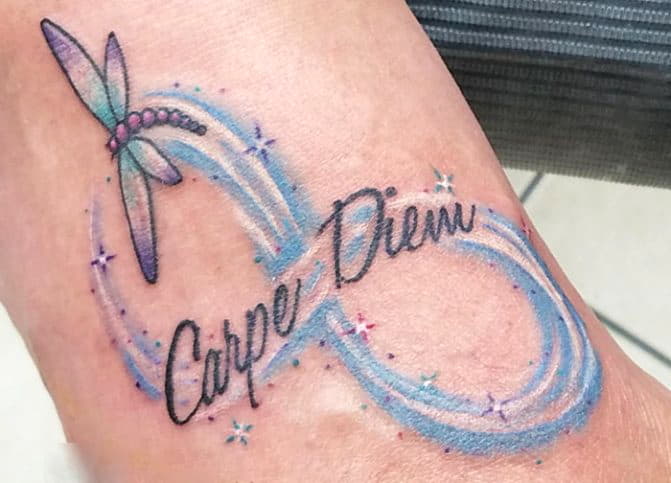

In Latin, the tattoo phrase "Seize the Moment" is an attractive, enduring decoration for fans of permanent markings. Although the winged expression is over 200 years old, it is still popular with many tattoo enthusiasts.
Harry Potter Universe
For fans of the Harry Potter series, very different characters and events are associated with death. The first option is the Deathly Hallows tattoo, a special symbol denoting the Elder Wand, the Resurrection Stone and the Cloak of Invisibility. All three objects, thought to be legendary, ended up in the hands of the characters in the story. Fans of Rowling's work often get themselves tattoos with this simple but original sign.
Tattoo of the Deathly Hallows, stylization
The same fans of Potteriana, which have always been on the side of the dark lord, whose name can not be pronounced aloud, prefer to order the symbol of the opponents of Potter and his friends. Today in the world there are many people on whose skin you can find a tattoo of the Death Eaters - henchmen of the main villain. It represents a skull, with a huge snake coming out of its mouth.
Original sketches and subjects. Styles and techniques of execution of tattoos with death
People have different attitudes to the demise and the characters that are associated with this process, from worship to rejection. For example, the Swedish monarch Charles XV had a tattoo of death to kings, printed on his arm. Quite original for a ruler. Are you wondering how it came to be that the king had such a tattoo? It's very simple - this monarch was a Frenchman who served in the army during the time of Napoleon Bonaparte.
During the wars, he was promoted to marshal and was remembered for his wonderful treatment of the captive Swedes. They were so impressed by the generosity of the Frenchman that they suggested that he change his confession and become their crown prince. And so it happened. In the end, the secret opponent of the monarchy himself ascended the throne. In memory of him, many people make a similar inscription on their wrist, forearm. Sometimes it is written on a ribbon around the arm, or next to the crown. Also looks great sketch - a skull with a crown and the words mentioned.
Tattoo of the skull in the crown
Another famous inscription is the tattoo of victory, or death. In different variations, it was used by revolutionaries in Spain, Cuba and other countries. Supporters of General Franco used the slogan "Freedom, or death". "Victory or Death" is the title of one of the episodes of Game of Thrones.
Also found is the tattoo faithful to death. Usually refers to fidelity to a lord, king, homeland, not a partner. But it is possible to interpret the inscription in different ways.
Nowadays, the death tattoo has taken on an all too subcultural meaning. It is exploited without understanding the real meaning, or inventing a new one. The reason for this is books, movies, TV series, and a lot of new cults. For example, the horsemen of the Apocalypse, led by Death on a pale horse, were turned into some fantasy characters, and in the series "Supernatural" the main reaper was killed with his own weapon. However, you have to hand it to the authors - in their version this character is not scary, but rather neutral.
Often people order a death tattoo with a clock - a pocket watch, or an hourglass. This is essentially the same "memento mori", only without the inscription. Each is allotted exactly as much as the higher powers decide. However, materialists have a different point of view.
However, there are those who prefer the oldschool and traditional. These types of tattoo art are still popular even in the XXI century.
The image of death on the back is often drawn waist-length, showing bony hands, with fingers that are decorated with massive rings. The scythe is not always a necessary detail of a death tattoo. But if it is the Grim Reaper that is depicted, then it, or the sickle, is present.
Interestingly, the immortality tattoo looks like a skull with a snake climbing out of its eye socket. The reptile in this context means wisdom and knowledge, preserved even after the death of their individual bearers. The phoenix is also considered a symbol of eternal life. The Chinese believed that immortality is symbolized by the butterfly. This is a surprising choice, given the transience of its life in our world.
Tattoo of a skull with a snake in its eyes
There are quite a few very interesting and atmospheric photos of death tattoo in the network. Take a look, study the options. Perhaps one of them will please you, inspire you. However, we recommend ordering sketches of tattoo death individually. For example, if you need to do a death on the shoulder, forearm, the best way will look three-dimensional black and white images with good detail.
Macabre, or the Dance of Death
One of the subgenres of art on the theme of memento mori is the Dance of Death, or Macabre (from Fr. Danse macabre). This subject of painting dates back to the late Middle Ages, but became popular during the Renaissance. The subject is an allegory on the theme of the frailty of human existence: Death dancing or playing music leads to the grave representatives of different social classes - kings, priests, merchants, peasants, children. Art on the theme of the Dance of Death, which also manifested itself in verbal form, as a series of rhyming mottos, grew out of the grim horrors of the 14th century: famine, the Hundred Years' War and, above all, the Black Death epidemic. The pandemic of the plague clearly demonstrated how death equals all, mercilessly maiming the population without the slightest regard for age or rank.
Some of the pictures of the Dance of Death are so painfully graphic that it is downright creepy. There is no doubt that they are capable of being a powerful reminder of personal mortality.
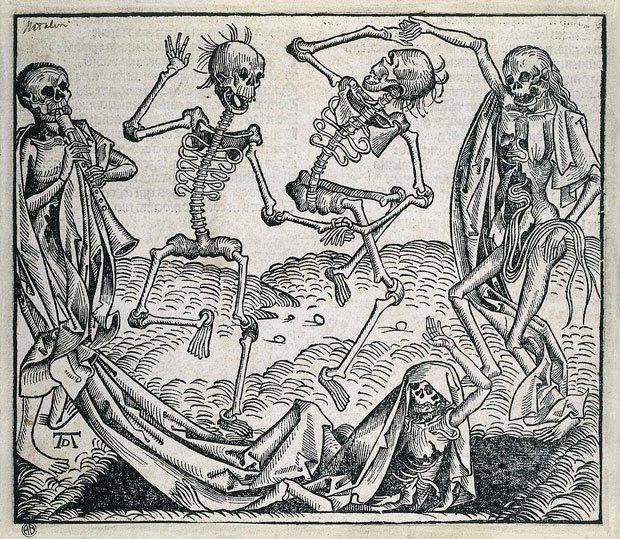

"The Dance of Death, Michael Wolgemuth, 1493
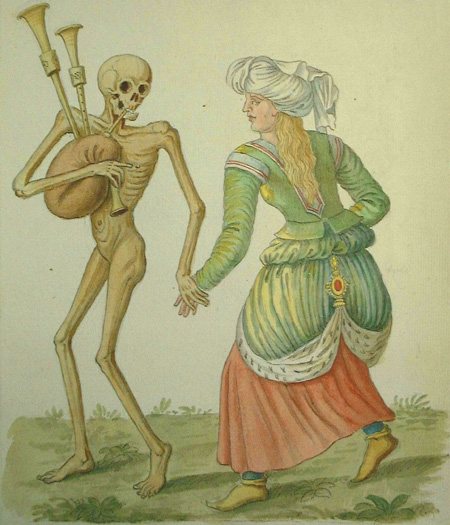

Fragment of the "Dance of Death" fresco in the Little Basel Cemetery, Emmanuel Büchel, 1773
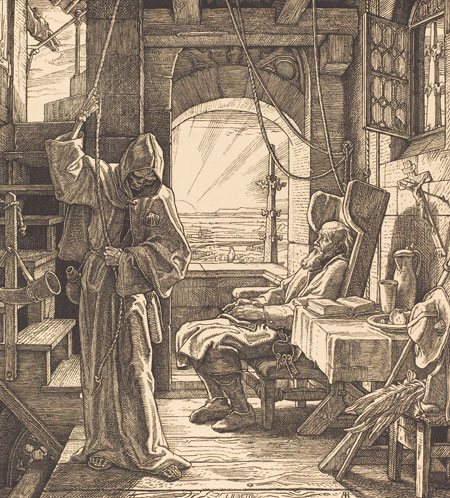

"Death the Friend," Alfred Rethel, 1851
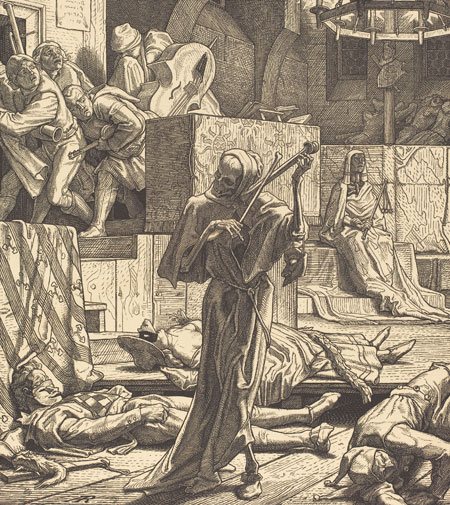

"Death the Enemy," Alfred Rethel, 1851.
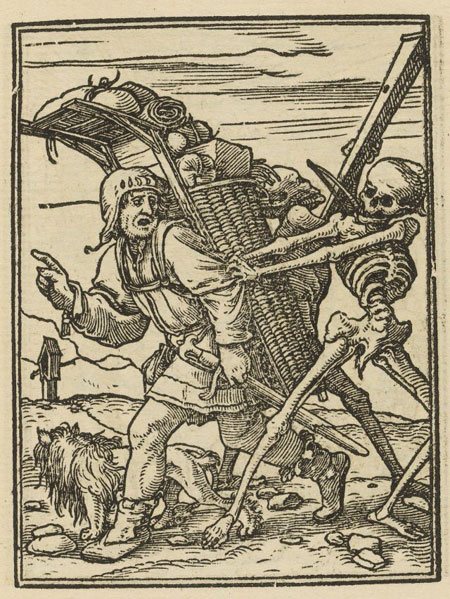

Drawing from "The Dance of Death," by Hans Holbein (Jr.), 1524-1526


Illustration from Heidelberger Totentanz, author unknown, 1488. Scholars believe that this is the first book devoted exclusively to the Dance of Death. The book contains a series of 38 woodcuts in which death is visited by citizens of various occupations.
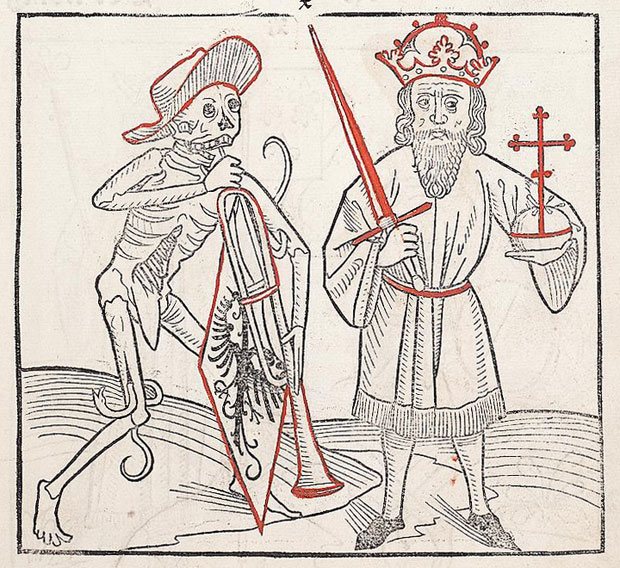

In most cases, the skeleton carries with it a musical instrument representing a particular motif.
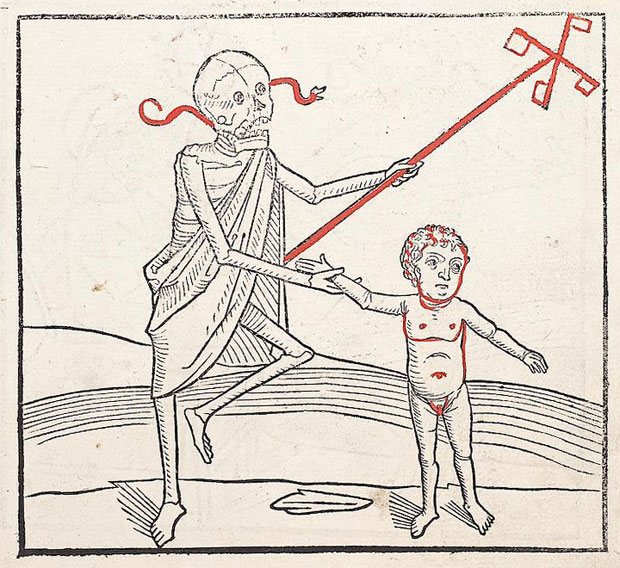

Unfortunately, already in ancient times people knew all too well that even children sometimes cannot avoid dancing with death.
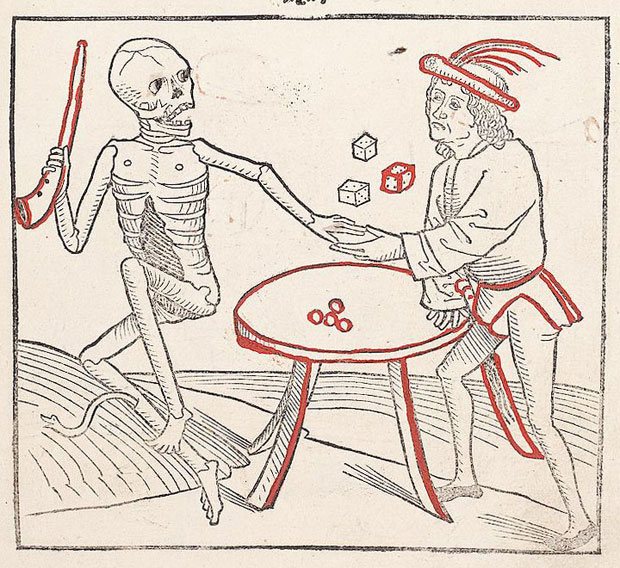

Often our lives are a game of chance. Luck comes and goes as well as it goes. But sooner or later we have to cash in our chips and go to the big casino in the sky.
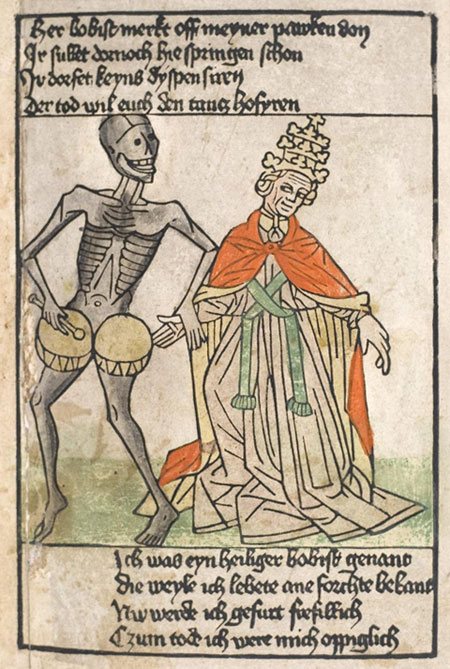

Illustration from Heidelberger Bilderkatechismus, author unknown, 1455. This may be one of the earliest depictions of the Dance of Death.
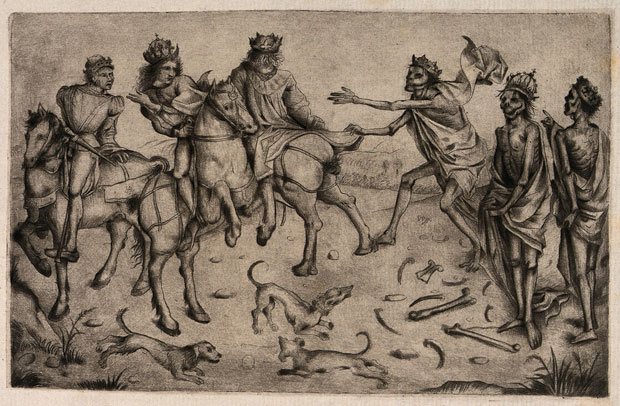

The medieval plot "Three dead and three living" was a popular theme of many murals and frescoes. According to the legend, three rich and proud young men - a prince, a duke, and an earl - meet three reanimated dead men. The first corpse warns the gentlemen that they will become as ugly as he, the second complains about hell, and the third speaks of the inevitability of death and the need to be prepared for it.
Sketches
Choose a sketch and get a tattoo if you're not afraid of course.
Tattoos in the form of various inscriptions are becoming quite popular nowadays. Given the possibilities of modern masters, you can put on your body absolutely any utterance so that few people will understand its meaning. This is because there are special fonts that allow you to turn letters into real works of art. However, in most cases, people want the inscription on their body to be easily readable in order to convey their thoughts to others. Thus, the Memento Mori tattoo occupies one of the leading positions in the ranking of the most popular tattoos with inscriptions.
Fonts and additional symbols
Applying the phrase on the body, the masters try to avoid simple and mediocre fonts. The melodious-sounding phrase is made in a carved and graceful style. The letters branch and curve gently, symbolizing the curvature of life's journey. For Memento Mori, varieties of Gothic fonts are also used, creating a connection of the phrase to medieval traditions and the activities of the Holy Inquisition, which had a direct bearing on the life and death of the Christian.
Antiqua old style allows you to recreate the spirit of the Renaissance, when life and death began to be perceived as a joint body and soul, which everyone must go through. Similar to this is the ambigram tattoo, which allows you to embody several themes and meanings in the image at once.
Colored drawings allow you to create abstract plots with a 3D effect. This can be achieved by using a rich palette of colors that adorns the traditional drawing with a play of colors, creating a convex or concave effect.
In professional tattoo-salons masters can offer to put a phrase in their own decorative fonts or in unusual writing, where the letters are put in italics. Experienced masters often offer to apply the image in the "thrash polka" style, which complements the images with realism. This effect is achieved by portrait painting, visual splashing and smearing of paints.
The tradition of minimalism is used to convey the hidden aura of the phrase. The understated approach calls for humility and blind adherence to a fated destiny.
History
The phrase has a very rich history. It was first uttered back in the days of ancient Rome. Once a warlord was returning home after an important victory. At that time, one of his slaves followed him and repeated this phrase so that the commander would not exalt himself above everyone else. Even in spite of his unprecedented successes, he was still a mere mortal who was powerless in the face of death.
The phrase was also popular among a certain number of seventeenth-century monks. Members of an order called the Brothers of Death used the phrase memento mori as a greeting to each other.
Modern Meaning
Gradually, the original meaning of this winged expression began to be forgotten. Today there are many Memento Mori tattoo bearers who know nothing about this historical background. The modern meaning of this tattoo has two interpretations:
- Nothing is eternal in this world.
- Everything was already predetermined by the higher forces long ago.
That is why this inscription can be found in people who want to emphasize the perishability of existence and the inability of man to change his fate.
So if you want to score yourself this inscription, you can easily look at the photo tattoo Memento Mori of any master and choose a variant that will be suitable for you.
0
Today in the vanity of everyday life we completely forgot that every person has a soul, feelings, emotions, hopes and aspirations. Although modern man with his "
consumerism
" most reminiscent of a piece of meat, devouring everything in its path. In former times it was not so noticeable, but even then, for some, it was obvious. That is why ancient philosophers tried in their works to discuss this topic, trying to convey their point of view to ordinary people. Today we will talk about an ancient winged expression, which should be known, or rather correctly interpreted by all who live under this Sun. As you have guessed, we are now going to talk about a wise proverb, this
Memento Mori
, the translation you can find out a little bit below. However, before I continue, I'd like to point you to a couple of other informative publications on the topic of proverbs and phrases. For example, what does it mean to dot all the I's and cross all the t's; how to understand If the stars are lit, it means that somebody needs it; the meaning of the phrase What we have is not kept, but lost is crying; translation of СеЛяВи, etc. So, let's continue,
what does Memento Mori mean
in Russian? This phrase was borrowed from the Latin language "
mementō morī
"which can be translated as "
Remember that you have to die"; "remember that you are mortal"; "remember death
«.
Memento Mori
- is a Latin expression that keeps people from forgetting that they are mortal and that each of us will have to leave this mortal world.
"Yes, man is mortal, but that would be half the trouble. The bad thing is that he is sometimes suddenly mortal, that's the trick!"
Bulgakov M. A. "The Master and Margarita."
Usually this phraseology is used in an allegorical sense, when one wants to warn and remind people that there is more to life than parties, drinking, drinking and other entertainment. In addition, we should not worry about nothing, because in the end, we will all come to the same denominator, and we will be two meters below ground level.
In ancient Rome, this phrase began to be uttered for generals and warlords who were returning home with victory. These high-ranking men had a slave placed behind their backs who periodically reminded them that even though the people worshipped him and all the women were crazy about him, he was still a mere mortal. The full phrase is believed to have sounded like "Respice post te! Hominem te memento!" which can be translated as "Look behind you! Don't forget that you are only human!"
Memento Mori
- this phrase was used in greetings by the members of the Trappist Order (not to be confused with the Knights Templar), almost unknown these days
Briefly about the Trappists: this is the Catholic branch of the Cistercian Order, which in turn split off from the Order of St. Benedict. The Benedictines had their own charter, with many clauses, and in addition to the commandments ""not to betray," "not to kill," "to love God.
"there was also a reminder to always remember death (
Memento Mori
), which was placed in section 44.
In addition, this greeting was used in their daily communication, the so-called Brothers of Death, French hermit monks of the Order of St. Paul (1620 - 1633).
It is worth remembering that in the Middle Ages was a veritable fashion for paraphernalia associated with death. Perhaps this is due to the fact that at that time in Europe....
"a lot of misfortunes and calamities. For example the plague from Asia, the Little Ice Age, when even the Black Sea was frozen, with bad harvests, sexually transmitted diseases from America, etc. Therefore, when one had a huge choice of what to die of, life was perceived more vividly and convexly. In connection with this, a wide variety of trinkets and other accessories, in the form of coffins, skulls, skeletons, were in good demand by merchants. They were not so much a tribute to fashion as served as a reminder of the frailty of existence and the inevitable end of all things. Later, from this strange fashion, the practice of mourning jewelry was formed, which was worn as an expression of mourning for a close relative or friend.
By reading this informative article, you have learned, the meaning of Memento Mori.
translation, and will now be able to elaborate on what this sad saying means.
Fans of tattoo art often choose to encrypt their mottos and life principles in a tattoo inscription in Latin. It is an elegant, melodic language, one of the oldest written Indo-European languages.
Beautiful phrases in Latin in tattoos
On this guy's arms are two winged phrases in Latin: "Fac fideli sis fidelis
" which translates to "Be faithful to the one who is faithful (to you)" and "
Fortunam suam quisque parat
"Every man finds his own happiness" or "Every man finds his own destiny".
The tattoo, in beautiful script, reads: "Primus inter pares
"which translates as "First among equals."
«Carpe diem
" is a famous winged Latin expression meaning "Live in the present," "Seize the moment.
«Vivere militate est
" is a saying of Seneca, which is translated as "To live is to fight."
Below are quotations and phrases in Latin, which are suitable for use in tattoos.
Tattoo Meaning
Tattoos that use the phrase "Memento Mori" are among the most popular and sought after. According to surveys, a large number of tattoo bearers with this phrase do not know its historical background.
The modern meaning of "Memento Mori" suggests the predetermination of life's path by higher forces. A person cannot change what is predetermined by Destiny. The second idea of the phrase is the finitude of existence.
Nothing in this world is eternal and death is the logical continuation of life. That is why the phrase "Memento Mori" is so beloved by fans of the transience of existence and the predetermination of the future.
According to scientists at the University of Missouri, who have done a lot of research on thinking about death, they have found that:
- The awareness of death pushes people toward altruism.
- The inevitability of death motivates concern for nature.
- Understanding death makes people more tolerant.
- The finitude of life makes you question its meaning.
"Memento Mori" has become an iconic phrase long before it became ubiquitous on the body in the form of tattoos. Moreover, in ancient times it was rarely used with the prefix "Carpe diem.
The phrase owes its appearance to the Romans, who liked to honor their consuls for military victories with magnificent triumphs at the entrance to Rome. However, in addition to the bright greeting of the victor, a small role of a slave was included in the holiday scenario, whose duty it was to stand behind the warlord and, holding a golden wreath above his head, constantly repeat: "Memento Mori".
Carpe diem Memento Mori
So Roman citizens reminded him that he too was a man and that his life too would one day end. The expression "Memento mori" was used by the Roman poet Horace in his Ode to Leucone. In Quintus Septimius Florence Tertullian's Apologetics, who lived at the turn of the second and third centuries, the expression is mentioned in another formulation: "Respice post te! Hominem te memento! Memento mori", which translates as "Turn around! Remember that you are a human being! Remember that you are a human being!"
In the seventeenth century, during the formation of secret societies, the expression "Memento Mori" began to be used as a greeting to one another by monks of the Brothers of Death order.
For the last 300 years the phrase has been found in cemeteries at tombstones or crypts.
